Best Practices for Code Collaboration and Sharing: How Not to Be *That* Developer
We’re here to dissect some best practices that will make you the kind of teammate your colleagues will actually *enjoy* working with, not just tolerate.

Ah, code collaboration—a necessary evil, or maybe, just maybe, a hidden gem of joy and productivity. We’re here to dissect some best practices that will make you the kind of teammate your colleagues will actually enjoy working with, not just tolerate. Let’s talk about how you can master the art of not being that developer, shall we?
1. Write Commit Messages Like a Human (No, Seriously)
You know what’s worse than trying to decipher a colleague's code? Trying to decipher their commit messages. "Fixed stuff" is not a message; it's a cry for help. Your future self and your teammates will thank you when you actually describe what "stuff" means. A good commit message should tell the story of why the change happened. Not an essay, but just enough context to understand why you took that left turn at Albuquerque.
2. Avoid Code Spaghetti—Make It Lasagna Instead
Everyone hates spaghetti—spaghetti code, that is. Your teammates don’t need an endless tangle of dependencies and callbacks; they need lasagna—structured, clear, layered. Think modular, think readable, think delicious. A good practice is to make sure functions do one thing and do it well. No one wants to try to unravel a thousand-line function at 5 PM on a Friday.
3. The Art of the Pull Request: Show and Tell, Not Hide and Seek
Pull requests are a lot like show and tell back in grade school. Show your code changes, and explain why you made them. If your pull request is longer than War and Peace, you might want to consider breaking it up. No one wants to spend their afternoon scrolling through an epic novel of a PR. Keep it digestible, add a summary, and for heaven's sake, please provide context on what problem you're solving.
4. Comment Wisely: The Goldilocks Approach
Too many comments and you’re just annoying everyone. Too few comments and you’re making everyone's life harder. What you want is just right. Use comments to explain the why, not the what (your code should already explain what it’s doing, unless it’s intentionally obfuscated—and we’ll assume you're not that evil). If you need a comment to explain your code, consider refactoring it instead.
5. Lint Like You Mean It
Linting might seem like a trivial annoyance, but it's the kind of trivial annoyance that makes or breaks code collaboration. Linting ensures consistency, which ensures sanity. Choose a linter everyone agrees on, like ESLint or Prettier, and actually stick to it. No one wants to deal with a codebase that has four different indentation styles, all warring for dominance. It’s a recipe for madness.
6. Be Honest in Code Reviews (But Not a Jerk)
Code reviews are not an excuse to show off how clever you are or to make someone feel small. If someone made a mistake, point it out constructively. And if something's good, let them know! Reviewing code is a chance to learn, teach, and uplift. When you’re stuck at an impasse, remember: it's not about winning a debate; it's about delivering good software together.
7. Documentation Is Love, Documentation Is Life
Look, nobody wants to write documentation, but everybody needs it. Think of it as writing a letter to your future self—or your teammate's future self. When you leave a trail of useful documentation, it's like leaving breadcrumbs in the forest, instead of a post-it note that just says "good luck." Future-you will appreciate that extra bit of effort when you need to work on this six months later and can’t remember a thing about it.
8. Don’t Be a Hero: Ask Questions
Hero syndrome is a real problem in code collaboration. No one needs a lone wolf refactoring an entire service at 3 AM without talking to the team. If you’re not sure about something, ask. Code collaboration is about team synergy, not creating your own personal monument to heroism. Don’t be afraid to say you’re stuck or confused—you’ll save time, reduce bugs, and make everyone’s lives a lot easier.
9. Communication Channels Are Not Optional
Your code is important, but so is communicating about it. Whether you use Slack, Teams, carrier pigeons, or smoke signals, make sure everyone knows what you’re working on, what roadblocks you're facing, and what needs review. Surprises are for birthdays, not for code collaboration.
10. Respect the Golden Rule of Git: Branches Are Cheap, So Use Them
Branches are not precious commodities—use them like there’s no tomorrow. Creating feature branches keeps your work separate, reduces conflicts, and makes merging a relatively painless experience. If you’re pushing straight to main, you better have a darn good reason—and even then, rethink it.
Collaboration is what makes great software great. If you follow these best practices, you’ll not only be a pleasure to work with, but you’ll also help your team create code that’s clean, maintainable, and maybe even a little fun to write. Because let's be honest—we're all in this together, and anything we can do to make collaboration less painful is a win in everyone's book.
And remember, the best code is the kind that doesn’t make you want to throw your laptop out the window. So go forth, collaborate wisely, and don’t be that developer.




